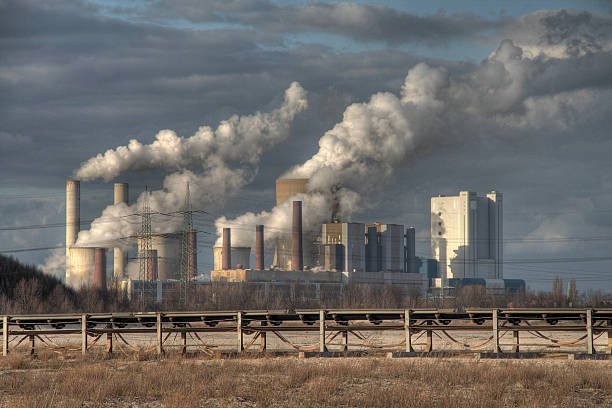Abstract:
Coal-fired electricity generation, despite its significant contribution to energy production, carries a multitude of negative externalities. This paper presents a case study of South Africa, a country heavily reliant on coal for its energy needs, to explicate the adverse environmental, health, and socioeconomic impacts of coal-fired power production.
Introduction
South Africa is amongst the world’s leading nations in terms of coal consumption and exportation. The country has vast coal reserves, which provide over 90% of its electricity supply and represent a significant portion of its economy (Eberhard, 2007). However, the economic benefits of coal power have led to overlooking its substantial negative externalities, defined as costs that are not directly borne by the coal industry but instead are distributed across society and the environment. To make informed decisions about its energy future, South Africa needs to fully account for these externalities.
The magnitude of the environmental impact from coal-fired electricity production is alarming, not only in terms of local pollution but also in its contribution to global environmental challenges. The combustion of coal emits significant quantities of pollutants, including sulfur dioxide, nitrogen oxides, particulate matter, and greenhouse gases like carbon dioxide (Burton et al., 2011). These emissions have far-reaching implications for air quality, water resources, soil health, biodiversity, and climate change. An analysis of these impacts reveals a far graver picture than what is often presented in economic assessments of coal-based energy.
Furthermore, the human health and socio-economic consequences of coal usage in South Africa are substantial and demand critical attention. Health problems linked to coal-related air pollution include respiratory diseases, cardiovascular issues, and premature deaths (Holland, 2017). The socio-economic impacts are also significant, ranging from displacement due to mining activities, to the strain on public health systems, and the significant societal costs resulting from health problems and environmental degradation (Spalding-Fecher et al., 2012). This paper aims to provide a comprehensive review of these negative externalities, using South Africa as a focal point for understanding the broader implications of reliance on coal power.
The Negative Externalities of Coal-Based Electricity Production
Environmental Externalities:
One of the most significant negative externalities of coal power production is environmental degradation. The coal combustion process emits vast amounts of pollutants, including sulfur dioxide, nitrogen oxides, particulate matter, and greenhouse gases (GHGs), such as carbon dioxide (Burton et al., 2011). These emissions contribute to global warming, acid rain, and ground-level ozone creation, which have harmful effects on ecosystems (Swilling & Annecke, 2012).
Here are a few concrete examples of environmental externalities from coal production in South Africa:
- Air Pollution and Acid Rain: South Africa’s Mpumalanga province, housing most of the country’s coal-fired power stations, has been reported as a global hotspot for nitrogen dioxide emissions. According to a report by Greenpeace (2018), the area’s excessive NO2 pollution, primarily attributed to coal-burning activities, has grave implications for air quality and health of the surrounding communities.
- Global Warming: South Africa is responsible for about 1.5% of global CO2 emissions, largely due to its heavy reliance on coal for electricity production (World Bank, 2019). In particular, Eskom, the state-owned power company, operates several of the world’s largest coal-fired power plants, including the Kendal and Kusile power stations, which are among the biggest point sources of CO2 emissions.
- Water Pollution and Scarcity: In the Upper Olifants River Catchment, excessive water usage and contamination by coal mines and power plants have severely affected water availability and quality (Oberholster et al., 2008). Coal mining activities have led to acid mine drainage, contributing to a high concentration of heavy metals in the water bodies, detrimental to both the ecosystem and human health.
- Land Degradation: In the Highveld region, coal mining activities have led to significant soil erosion, loss of productive agricultural lands, and landscape alteration (Roux et al., 2016). Open-pit mines leave behind vast areas of unusable land, contributing to loss of biodiversity and ecosystem services.
Health Externalities:
The pollutants from coal-fired power plants also cause severe public health issues. According to a report by Holland (2017), coal emissions are linked to respiratory ailments, cardiovascular diseases, and premature deaths. The report estimates that coal-related air pollution caused over 2,200 premature deaths in South Africa in 2012 alone.
Here are a few specific examples of health externalities associated with coal-fired power production in South Africa:
- Respiratory Diseases: Air pollution caused by coal combustion can lead to increased rates of respiratory diseases. A prime example of this is the Highveld region in South Africa. In a 2018 report, Greenpeace claimed that Mpumalanga, an area within Highveld, had the highest levels of nitrogen dioxide pollution across six continents, predominantly because of the numerous coal-fired power plants and coal-to-liquid fuel industry within its vicinity (Greenpeace, 2018). The high pollution levels have been linked with increased respiratory illnesses among local communities, including asthma and chronic bronchitis (Nkosi et al., 2020).
- Cardiovascular Diseases: Coal-related air pollution also contributes to cardiovascular diseases. In a South African study, Pope et al. (2015) found a direct correlation between exposure to particulate matter from coal power plants and increased hospital admissions due to cardiovascular events.
- Premature Deaths: According to the “Health impacts of coal-fired power plants in South Africa” report by Holland (2017), particulate matter and sulfur dioxide emissions from coal power plants led to an estimated 2,239 premature deaths in 2012. These included approximately 157 infants due to lower respiratory infections and more than 1,000 adults due to chronic obstructive pulmonary disease, lung cancer, and heart disease.
Socioeconomic Externalities:
Coal power generation also induces socio-economic externalities. The mining and burning of coal can lead to water scarcity and pollution, displacing communities and affecting livelihoods (Ojedokun et al., 2020). Additionally, the health impacts of coal-fired electricity generation strain public health systems and generate significant societal costs (Spalding-Fecher et al., 2012).
Examples:
Expanding on the socioeconomic externalities of coal mining and combustion in South Africa requires diving into specific examples. These include impacts on water resources, local communities, and the healthcare system:
- Water Resource Impacts: The Olifants River Water Resources Development Project (ORWRDP) is an apt illustration of water resource impacts. The river is affected by coal mining, especially from Acid Mine Drainage (AMD), a toxic wastewater byproduct. AMD has not only devastated aquatic life but also compromised the water quality, impacting local agricultural activities and households dependent on the river for their water needs (Hobbs et al., 2008).
- Community Displacement and Livelihood Impacts: The case of the Lephalale region, home to the Medupi power station, illustrates community displacement and livelihood impacts. As South Africa’s newest coal-fired power plant, its construction displaced numerous local communities, sparking a complex resettlement process. Furthermore, the environmental degradation has affected local farming activities, a primary source of livelihood for many (Muswazi & Burger, 2019).
- Health System and Cost Impacts: Air pollution from coal-fired power plants significantly contributes to respiratory and cardiovascular diseases, straining South Africa’s health system. The Highveld region, with many coal mines and power plants, has been dubbed a “priority area” due to its poor air quality. The external costs of air pollution in this region were estimated at $2.37 billion in 2014 (Bench Marks Foundation, 2014).
Conclusion:
In the face of these negative externalities, South Africa is at a critical juncture to reassess its energy policy. While coal has fueled its economy for decades, the environmental, health, and socioeconomic costs are considerable and rising.
References:
- Eberhard, A. (2007). The future of South African coal: market, investment, and policy challenges. Program on Energy and Sustainable Development, Stanford University, Stanford.
- Burton, J., Winkler, H., & Spalding-Fecher, R. (2011). A second life for legacy mining sites: utility-scale solar photovoltaics on mine lands in South Africa. Journal of Energy in Southern Africa, 22(4).
- Swilling, M., & Annecke, E. (2012). Just transitions: Explorations of sustainability in an unfair world. UCT Press.
- Holland, M. (2017). Health and environmental impacts of coal-fired power stations in South Africa. GroundWork.
- Ojedokun, O. S., Bello, S. A., & Afolayan, A. J. (2020). An assessment of the impacts of acid mine drainage on socio-economic development: A case study of the Witwatersrand Basin, South Africa. Heliyon, 6(2), e03403.
- Spalding-Fecher, R., Joyce, B., & Winkler, H. (2012). Climate change mitigation and the energy sector in South Africa. Climate Policy, 12(sup1), S38-S51.






